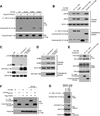Cleavage of NIK by the API2-MALT1 fusion oncoprotein leads to noncanonical NF-kappaB activation
- PMID: 21273489
- PMCID: PMC3124150
- DOI: 10.1126/science.1198946
Cleavage of NIK by the API2-MALT1 fusion oncoprotein leads to noncanonical NF-kappaB activation
Erratum in
- Science. 2011 Apr 22;332(6028):421
Abstract
Proper regulation of nuclear factor κB (NF-κB) transcriptional activity is required for normal lymphocyte function, and deregulated NF-κB signaling can facilitate lymphomagenesis. We demonstrate that the API2-MALT1 fusion oncoprotein created by the recurrent t(11;18)(q21;q21) in mucosa-associated lymphoid tissue (MALT) lymphoma induces proteolytic cleavage of NF-κB-inducing kinase (NIK) at arginine 325. NIK cleavage requires the concerted actions of both fusion partners and generates a C-terminal NIK fragment that retains kinase activity and is resistant to proteasomal degradation. The resulting deregulated NIK activity is associated with constitutive noncanonical NF-κB signaling, enhanced B cell adhesion, and apoptosis resistance. Our study reveals the gain-of-function proteolytic activity of a fusion oncoprotein and highlights the importance of the noncanonical NF-κB pathway in B lymphoproliferative disease.
Figures




Similar articles
-
MALT1 and the API2-MALT1 fusion act between CD40 and IKK and confer NF-kappa B-dependent proliferative advantage and resistance against FAS-induced cell death in B cells.Blood. 2005 Apr 1;105(7):2891-9. doi: 10.1182/blood-2004-06-2297. Epub 2004 Dec 14. Blood. 2005. PMID: 15598810
-
Protease activity of the API2-MALT1 fusion oncoprotein in MALT lymphoma development and treatment.Future Oncol. 2011 May;7(5):613-7. doi: 10.2217/fon.11.35. Future Oncol. 2011. PMID: 21568677 Free PMC article. Review.
-
Selective expansion of marginal zone B cells in Emicro-API2-MALT1 mice is linked to enhanced IkappaB kinase gamma polyubiquitination.Cancer Res. 2006 May 15;66(10):5270-7. doi: 10.1158/0008-5472.CAN-05-4590. Cancer Res. 2006. PMID: 16707452
-
The API2-MALT1 fusion exploits TNFR pathway-associated RIP1 ubiquitination to promote oncogenic NF-κB signaling.Oncogene. 2014 May 8;33(19):2520-30. doi: 10.1038/onc.2013.195. Epub 2013 Jun 17. Oncogene. 2014. PMID: 23770847 Free PMC article.
-
Anti-apoptotic action of API2-MALT1 fusion protein involved in t(11;18)(q21;q21) MALT lymphoma.Apoptosis. 2005 Jan;10(1):25-34. doi: 10.1007/s10495-005-6059-6. Apoptosis. 2005. PMID: 15711920 Review.
Cited by
-
The protease activity of the paracaspase MALT1 is controlled by monoubiquitination.Nat Immunol. 2013 Apr;14(4):337-45. doi: 10.1038/ni.2540. Epub 2013 Feb 17. Nat Immunol. 2013. PMID: 23416615
-
Combining precision oncology and immunotherapy by targeting the MALT1 protease.J Immunother Cancer. 2022 Oct;10(10):e005442. doi: 10.1136/jitc-2022-005442. J Immunother Cancer. 2022. PMID: 36270731 Free PMC article. Review.
-
Role of the CARMA1/BCL10/MALT1 complex in lymphoid malignancies.Curr Opin Hematol. 2016 Jul;23(4):402-9. doi: 10.1097/MOH.0000000000000257. Curr Opin Hematol. 2016. PMID: 27135977 Free PMC article. Review.
-
Mechanism and specificity of the human paracaspase MALT1.Biochem J. 2012 Apr 1;443(1):287-95. doi: 10.1042/BJ20120035. Biochem J. 2012. PMID: 22309193 Free PMC article.
-
The Therapeutic Potential of Targeting NIK in B Cell Malignancies.Front Immunol. 2022 Jul 12;13:930986. doi: 10.3389/fimmu.2022.930986. eCollection 2022. Front Immunol. 2022. PMID: 35911754 Free PMC article. Review.
References
-
- Isaacson PG, Du MQ. MALT lymphoma: from morphology to molecules. Nat Rev Cancer. 2004;4:644. - PubMed
-
- Thome M. Multifunctional roles for MALT1 in T-cell activation. Nat Rev Immunol. 2008;8:495. - PubMed
-
- Lucas PC, et al. Bcl10 and MALT1, independent targets of chromosomal translocation in malt lymphoma, cooperate in a novel NF-kappaB signaling pathway. J Biol Chem. 2001;276:19012. - PubMed
-
- Sun L, Deng L, Ea CK, Xia ZP, Chen ZJ. The TRAF6 ubiquitin ligase and TAK1 kinase mediate IKK activation by BCL10 and MALT1 in T lymphocytes. Mol Cell. 2004;14:289. - PubMed
-
- Lucas PC, et al. A dual role for the API2 moiety in API2-MALT1-dependent NF-kappaB activation: heterotypic oligomerization and TRAF2 recruitment. Oncogene. 2007;26:5643. - PubMed
Publication types
MeSH terms
Substances
Associated data
- Actions
- Actions
Grants and funding
LinkOut - more resources
Full Text Sources
Other Literature Sources
Molecular Biology Databases
Miscellaneous

